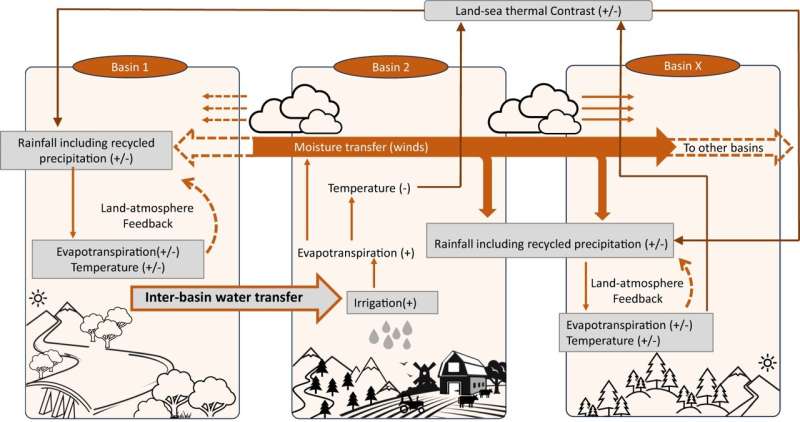October 9, 2023 report
This article has been reviewed according to Science X's editorial process and policies. Editors have highlighted the following attributes while ensuring the content's credibility:
fact-checked
peer-reviewed publication
trusted source
proofread
Models suggest interlinking rivers in India to meet water demand may adversely impact monsoon rainfall amounts

A team of civil engineers and meteorologists at the Indian Institute of Technology, working with colleagues from the Indian Institute of Tropical Meteorology and the University of Hyderabad, has found, via modeling, that a plan to interlink rivers in India to capture rain runoff could inadvertently have a negative impact on the amount and location of monsoon rainfall.
In their study, published in the journal Nature Communications, the group used a variety of modeling techniques to test the possibility of unintended changes to weather patterns in India as interlinking projects are undertaken.
Officials in India have a clear problem on their hands—their country has a population of 1.4 billion people, the highest of any country in the world. And it is still growing. Such growth is presenting a host of problems, including how to feed so many people, sustain economic growth and manage water. This last problem has become dire—for India to feed its people, it must grow more food and that will require more water. But water availability is decreasing.
To meet the demand, scientists and government officials have proposed and instigated a plan that entails digging canals between rivers to interlink them, with the idea of capturing more rainfall. Instead of allowing most of its rainfall to run off into rivers and then to the sea, the country plans to divert some of that water into other rivers that can be shunted into drier areas, where it can be used for irrigation. But doing so, the researchers on this new effort insist, could have unintended and perhaps disastrous side effects.
Prior research has shown that exchange of material such as aerosols into the atmosphere can lead to a land-atmospheric feedback system, resulting in cooling of temperatures in a region, and subsequent changes in rainfall amounts. Likewise, irrigation efforts have been found to instigate land-atmosphere feedback as water from such systems evaporates into the atmosphere. Such systems have been found to have an impact on local hydrological cycles, and in some cases, can impact monsoon rains. These findings convinced the team on this new effort to take a closer look at the possible impact of interlinking rivers.
To estimate possible impacts, the team used causal delineation techniques along with general climate models that have been modified to focus specifically on India and its weather, and also a reanalysis of datasets built from land-atmosphere feedback systems that already exist in India.
The researchers found that land-atmosphere feedbacks from interlinked rivers could generate causal pathways between river basins in India—as one example, they found incidences of decreased rainfall in September (during monsoon season) by up to 12% in parts of the country that are already experiencing water shortages. They also found evidence of some areas experiencing more dryness during El Niño years. They conclude that more study is required before approving new river linking efforts.
More information: Tejasvi Chauhan et al, River interlinking alters land-atmosphere feedback and changes the Indian summer monsoon, Nature Communications (2023). DOI: 10.1038/s41467-023-41668-x
Journal information: Nature Communications
© 2023 Science X Network




















